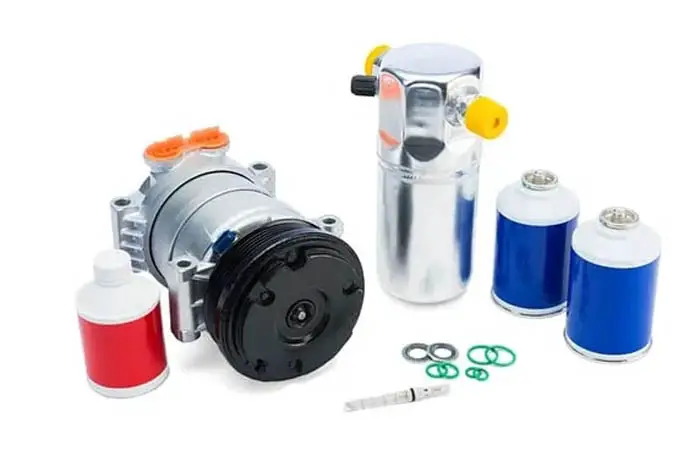
According to a SEAT expert, an interior temperature of 35°C causes the driver to react 20% slower than at 25°C.
For this reason, it is very important to keep the passenger cabin cool. A car cooling setup means a lot on hot days. If you are experiencing issues with your car’s cooling system and want to understand the problem, this article is for you.
So, this article is for you, both for AC technicians and for non-techie guys. This article provides a comprehensive overview of the seven basic car air conditioning system parts in a clear and practical manner.
Car AC System
An automobile or car air conditioning system works to cool the inside air of the vehicle cabin.
The main purpose of the auto air conditioning system is to make the internal temperature of the air lowered and comfortable for occupants. The automotive air conditioning system cleans, dehumidifies, and circulates the interior air of the car cabin.
Parts of the Car AC System
The cooling system consists of different car cooling setup parts located under the hood and inside the cabin. In working air conditioning all vehicle ac parts work together to bring comfort to the car occupant.
All component in an automobile ac system is also almost interlinked together with each other to cool the inside air of the vehicle. The air conditioning system consists of some major components that are mentioned below.
The 7-Car AC System Parts
- Compressor:
- Condenser:
- Receiver Drier:
- Accumulator:
- Expansion (metering) valve:
- Orifice Tube:
- Evaporator:
1. Compressor:
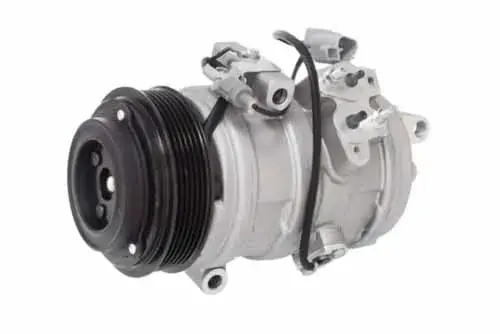
The most important component of the whole system is the compressor and also the heart of the air conditioning system. Without it the whole system is useless.
The working of an automobile ac compressor as its name suggests that it compresses refrigerant (remember it compresses only in gaseous form, not in liquid form). It compresses low-pressure gas/refrigerant that comes from an internal heat exchanger/evaporator and makes it into a high-pressure state converting it into a liquid refrigerant which in turn enables the further flow of the refrigerant. Undoubtedly, it causes both temperature and pressure rise to the refrigerant which is sent to the condenser which is used in ac takes heat from the gas/refrigerant.
It consists of a free-spinning pulley, magnetic clutch, and electromagnetic coil. AC works with the working of the compressor which receives power from a crankshaft-driven belt. It uses a magnetic clutch to connect and disconnect the compressor from the engine.
When you push the AC button, the electromagnetic coil is activated. Which attracts the magnetic clutch to a pulley, and rotates together as one assembly resulting in compressing the gas/refrigerant, and pushing it into the external heat exchanger.
Sometimes a worn belt will cause the AC compressor to NOT function properly. if it leaks from the central “O” ring and is also seized, will make a clicking noise. Better to replace it.
Related Post: Types Of Compressor Oil: Mineral, PAO, POE, PAG Oil, & Purposes
2. Condenser:
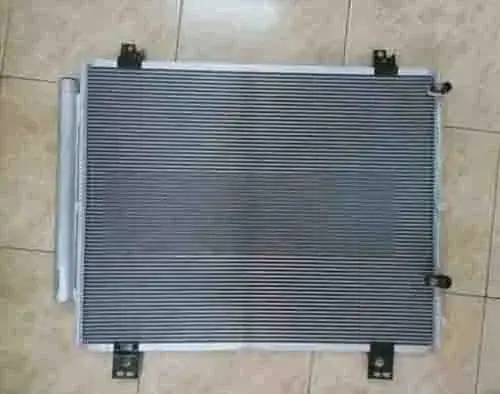
A vehicle condenser is an essential car’s ac component used to condense vapor refrigerant into liquid refrigerant by dissipating heat from it. Now here is the important question what does this component do?
The answer is, that it is a large heat exchanger, unlike an evaporator, which absorbs heat. It releases heat from the gas/refrigerant by driving fresh air across it through the condenser cooling fan or by natural flow while driving. Heat is released which was produced by the compressor through forced convection provided either by radiator fan or by separated fan.
An engine heat exchanger’s job is to release heat from the engine coolant, while an external heat exchanger’s job is to release heat from the AC fluid.
In the whole cooling setup, this component is more prone to physical damage than any other part because of its frontal location. It is made of aluminum, located in front of the radiator, and looks like a small radiator.
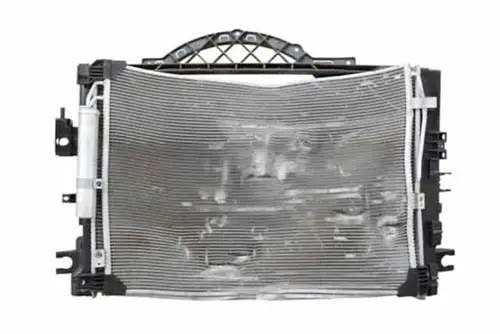
Small stones, dust, leaves, and other objects on the road can hit the external heat exchanger leading to leaks and corrosion. An external heat exchanger can also be susceptible to internal damage.
Foreign materials inside the ac can add up in the condenser’s small tubes, which block the flow of gas/refrigerant. A damaged AC external heat exchanger should be replaced, instead of repaired if the air conditioning isn’t working.
Related Post: How Car Air Conditioner Works (Animation): Science-Based
3. Receiver Drier:
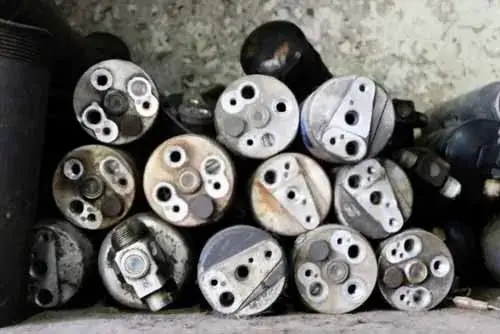
Also called a filter drier. It is an important vehicle part. A vehicle receiver dryer is used for filtration which consists of a metal canister containing desiccant (A substance that absorbs water).
It is located in a high-pressure line in the cooling setup between the condenser outlet and the expansion valve inlet. When the fluid leaves the condenser and passes through the receiver drier, it cleans the gas/refrigerant and makes it perfect for metering operations. The receiver drier has three main purposes which are mentioned below.
Functions Of The Car A/C Receiver Drier
1. Acts As A Storage Container:
The receiver acts in the car ac as a medium to store oil and ac fluid.
2. Acts As A Cleaner:
The vehicle receiver drier acts as a filter. It filters debris and contaminated foreign materials inside the ac gas/refrigerant in the cooling setup. Filtering of the system gets done here.
3. Acts As A Drying Agent
The vehicle receiver drier acts as a cleaner. Inside a receiver drier, there is a desiccant that absorbs moisture from the ac fluid. Moisture can get into the car’s air conditioning system from humidity in the air during manufacturing or service.
If moisture is not removed from the system, it can become ice crystals and lead to blockage and mechanical damage.
The receiver drier stores a short amount of moisture. If the receiver drier became defective and shows the symptoms of a leak, clogged, or hear a rattling noise.
You should replace the receiver-drier. Also when a compressor is replaced or the system is retrofitted, you should also replace the receiver-drier.
Related Post: Refrigerant Is Filtered Via Receiver Drier
4. Car AC Accumulator:
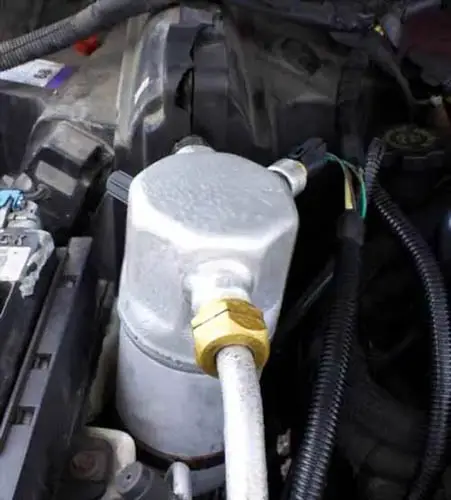
The vehicle accumulator is an important car cooling setup component. It is much like in purpose to receiver drier. It is a metal canister filled with desiccant and filter.
But the main difference is that the vehicle accumulator is larger in size than the receiver drier. It is located in a low-pressure line between the evaporator outlet port and the compressor inlet port. You should remember that AC accumulators are only used with an orifice pipe system.
Accumulator does the same job as the receiver drier does. It cleans the system by absorbing the contaminated materials inside the ac system. It filters moisture and also stores liquified ac fluid.
You might be wondering by knowing that an orifice pipe cannot fully convert liquid-refrigerant to vapor form, which causes compressor damage.
For this purpose, the accumulator is installed before the compressor to store the liquified fluid for a while. As it is only designed to compress the gaseous form, not the liquified one.
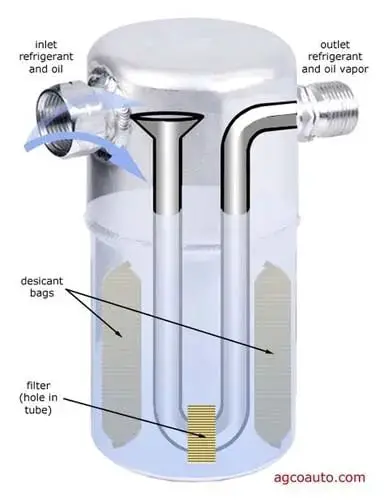
The accumulator stores liquid-refrigerant of ac at the bottom, which the compressor cannot suck. The liquified fluid gradually vaporizes Off. The vapor gas/refrigerant rises to the top and continues to go to the compressor. These vapors then enter the compressor where it is recycled in it.
5. Expansion Valve:
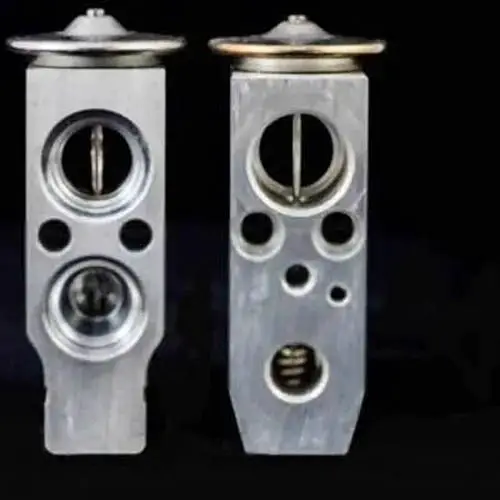
The vehicle thermal expansion valve is an important vehicle part, located in the inlet of the evaporator. It is the boundary between high-pressure and low-pressure lines in air conditioning. It is this valve that creates a cooling effect in the fluid.
The expansion-valve as its name suggests that it expands the refrigerant. You will feel the air cools in a short amount of time, this is due to the rapid expansion of the ac gas/refrigerant. Cooling is produced in this step by gas/refrigerant sent by the condenser in order to release the pressure of the refrigerant.
In the evaporator, for the further process, ac gas/refrigerant is spread out in a relatively large area. This expansion causes its pressure and temperature to rapidly drop, resulting in a cooler evaporator. A thermal-expansion valve is used in vehicles that enable the passenger to change the temperature according to the requirement.
The vehicle thermal valve converts ac gas/refrigerant from the liquid state to the vapor state by spraying a small portion of gas/refrigerant into the evaporator. In other words, it controls its flow by limiting pressure, which is also called “Metering”. A movable rod that moves back and forth in the inside expansion valve permits it to go and stop.
Related Post: 7 Reasons Your Car Stalls/Shuts Off When AC Is Turned ON
Symptoms Of A Bad Car A/C Expansion Valve
Warm air or frost coming out from the vents or the cooling setup is always ON is the symptom of a bad vehicle thermal valve.
6. Car A/C Orifice Tube:

The vehicle orifice pipe is also an important car cooling setup part. It is an alternative to the thermal valve. It is used in the system where the thermal valve doesn’t use.
The vehicle orifice pipe is located often in the condenser outlet. It divides both high and low-pressure systems. The vehicle orifice works the same way as the thermal valve does. It changes the ac fluid from a liquid state to a vapor state.
But the major difference is, that the thermal valve has a movable rod that controls the ac fluid flow. Whereas an orifice pipe has no movable part. It cannot control the amount of fluid passing through it and has a fine fixed hole restriction through which fluid passes.
The vehicle orifice pipe cannot alter the fluid flow speed the way the thermal valve does. To vary the fluid flow speed it depends solely on the compressor to turn ON and OFF and also on the regulating valve fitted in the compressor.
A filter is located on the inlet side of the orifice pipe to filter the debris. These debris and metal particles can sometimes clog the orifice pipe.
Remember one important thing in a thermal valve system, the receiver-drier is used with the thermal valve. Whereas in the orifice pipe system, the accumulator is used with an orifice pipe.
Related Post: Clogged Expansion Valve Or Orifice Tube
Signs Of Bad Car A/C Orifice Tube
The symptom of a bad or defective vehicle orifice pipe is intermittent cooling or AC blowing cold air than warm air, and abnormal pressure reading like low side-pressure reading below normal reading or high side pressure reading above the normal high-pressure reading.
7. Car A/C Evaporator:
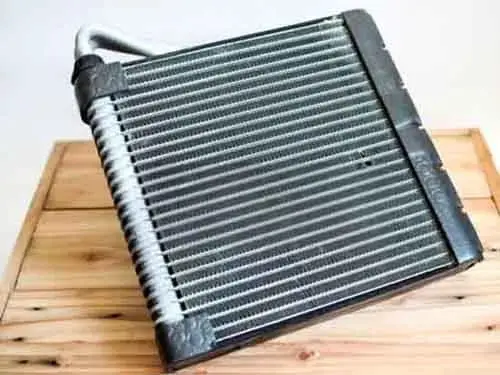
The vehicle’s-evaporator also called the internal heat exchanger is the most important car cooling setup part. It is the same as the radiator buried deeply hidden inside the dashboard behind the ac vent in the driver/passenger compartment. It is a device that looks like another heat exchanger.
The vehicle’s internal heat exchanger is a component where evaporation happens. In other words, an internal heat exchanger is present in the cabin which in turn converts the liquid refrigerant flowing through the evaporator into the vapors form. Vapors in turn provide cooling with the help of the blower fan to the internal atmosphere of the cabin. One important parameter is the boiling point that is used to change the phase according to requirement.
It consists of a series of tubes with fins made from aluminum because aluminum is a good conductor.
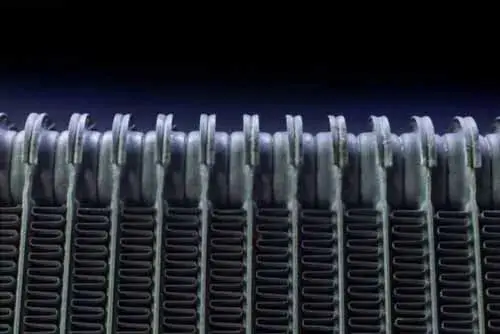
It is a heat exchanger. It takes heat from the passenger’s cabin which in turn goes into the evaporator. It also dehumidifies the air.
Now here is the interesting part that why dehumidification is necessary. Let me break this down for you.
You might know that heat remains more in humid air than in dry air because humid air contains more water molecules. That is why when the air is drawn across the internal heat exchanger/evaporator, water molecules condense at the surface of the internal heat exchanger/evaporator and drip out of the vehicle through a drain pipe making the air dry. This increases the effect of coolness.
Some vehicles have two evaporators. One is under the dashboard and the second one is located in the rear section behind a side panel or the ceiling above the rear passenger.
Signs Of Damaged Car A/C Evaporator
The biggest sign of a defective vehicle internal heat exchanger/evaporator is Leakage. Other signs are weak cool air, strange odor, and even the compressor will not turn ON.
Heat Remains More in Humid Air Than in Dry Air.
Conclusion
In conclusion, all components of ac are interlinked with each other. As we obtain cooling from the cold evaporator then fluid having low pressure is then sent to the compressor which in turn increases the pressure over the vapors and converts the vapor refrigerant into the liquified form. The liquid-refrigerant is then sent to condense which lowers the temperature of this refrigerant. Then it is moved to the expansion valve which in turn releases the pressure from the refrigerant.
Sign Up



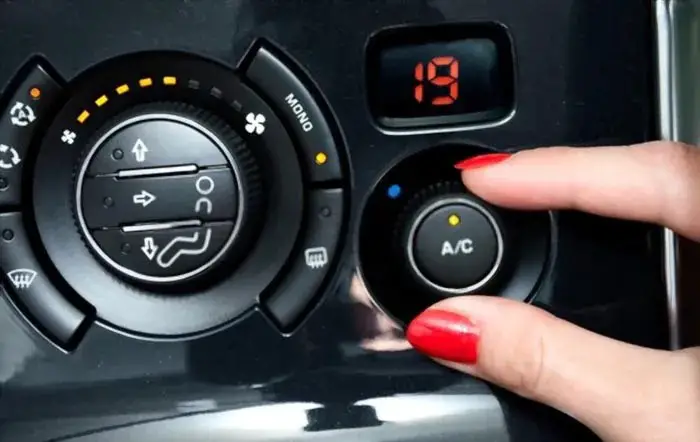

I like your presentation and agree with much of this information. I learned some basic parts of the air conditioning system of a car after reading this article.
Norman A. Rivera! Thanks for your valuable feedback